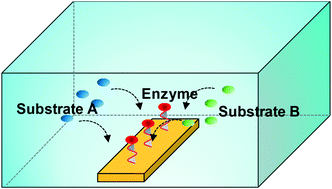Diffusion–reaction kinetics of microfluidic amperometric biosensors†
Abstract
Amperometric biosensors are widely applied for rapid biomarker detection in physiological and environmental samples. The dynamics and linearity of the current signal, however, are only partially understood. This study investigates the diffusion–reaction kinetics of amperometric biosensing using a self-assembled monolayer (SAM) based biosensor for bacterial 16S rRNA. A numerical model is developed to optimize the chamber dimensions and elucidate the concentration dependences of the biosensor. The results revealed that depletion of substrates associated with the chamber dimension can limit the current signal in a target concentration dependent manner. This study provides practical guidelines in the design and interpretation of microfluidic amperometric biosensors for biochemical applications.



 Please wait while we load your content...
Please wait while we load your content...